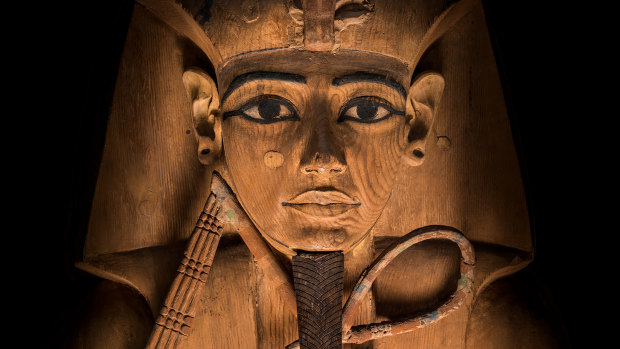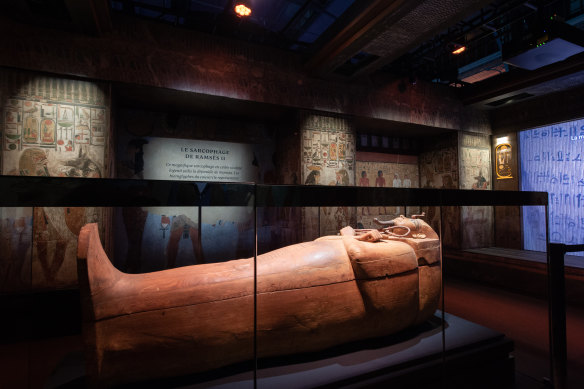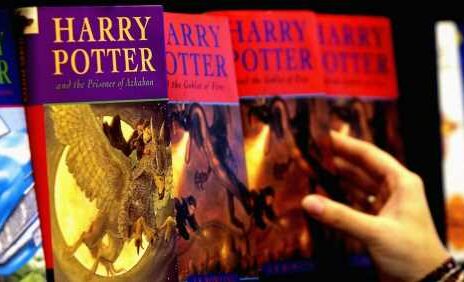Save articles for later
Add articles to your saved list and come back to them any time.
Key points
- The coffin of Ramses II and its occupant was discovered in 1811 within the Royal Cache at Deir el-Bahari – an Egyptian archaeological site located on the west bank of the Nile River, opposite the city of Luxor and east of the Valley of the Kings.
- The cedar coffin of Ramses II was not originally designed for the pharaoh. Probably dating from the late 18th Dynasty, it would have been overlain with gilding and inlays in precious stones or glass.
- The king is represented as an Osiris: arms crossed on his chest, he holds the two royal sceptres, the crook (known as the heqa) and the whip (the nekhakha).
The sarcophagus of one of Ancient Egypt’s greatest pharaohs is set to make the rare journey to Australia after the Australian Museum negotiated a loan of the priceless antiquity for its upcoming antiquity blockbuster exhibition.
The sarcophagus once contained the mummified remains of Ramses II, who ruled for almost 67 years during the 13th century BC and oversaw major military conquests and monumental construction projects while fathering more than 100 children.
Ramses II’s coffin will be making the journey to Australia for a blockbuster exhibition about one of ancient Egypt’s greatest Pharaohs.
It will join 181 priceless artefacts and ornate treasures to go on public display at the museum next month, with the sarcophagus the star attraction of its Ramses & The Gold of the Pharoahs blockbuster. It’s the first of three exhibitions on Ancient Egypt opening in Sydney, Canberra and Melbourne in the next several months.
The exceptional loan was announced by the Egyptian government in Cairo on Monday evening Australian time as renowned archaeologist, Dr Zahi Hawass, revealed his team had made major discoveries while excavating the burial chamber of the 19th Dynasty king. These include never-before-seen funerary texts and burial chamber reliefs ushering the king into the afterlife, and showing Ramses’ god-like status in ancient Egypt.
Ramses’s coffin at the Grande Halle de la Villette in Paris. Credit: Australian Museum
Archaeologists say they are inching closer to finding the passage linking Ramses’ burial chamber with that of his sons in the Valley of the Kings, near Luxor. The cedar coffin of Ramses II now on its way to Sydney had been included in the Paris leg of the multi-city exhibition tour of ancient Egyptian artefacts, in recognition of the French conservators who helped save the mummy from decay 50 years ago.
It was to have returned to Cairo until museum chief executive Kim McKay intervened.
“I walked up to the Minister of Tourism in Egypt, a very charming man, and introduced myself, and he did this beautiful thing of kissing my hand. And I said, ‘I’m Kim from Australia, and I want that coffin’. He laughed. We got chatting, and he said he would see what he could do.
“This beautiful sarcophagus is a work of inestimable value and a powerful symbol of one of the greatest leaders of the ancient world. Egyptians worshipped their Pharaohs, and their devotion to Ramses II can be seen through the craftsmanship of the coffin.”
Costs of transporting the coffin to Australia will be covered by ticket admission, Ms McKay said.
Hawass says proceeds the Egyptian government receives from the ten-city blockbuster tour, of which Sydney is the fourth stop, is helping conserve the tomb and its newly discovered contents including those showing Ramses with the Lord of Death and Rebirth, Osiris.
More than 250,000 tonnes of rubble has been removed from the flood-damaged tomb which, at 200 metres long, is the largest royal tomb in the Valley of the Kings.
“The tomb of Ramses had been completely damaged by floods and nobody had excavated the tomb,” Hawass says. “Now, I’m looking for the tunnel from the burial chamber of Ramses II to the tomb of his sons.
“If I discover this tunnel it will be another great discovery. I’m working right now in the Valley of the Kings. Because of this exhibit to the public, we will be able to open this tomb to the public in maybe two or three years maximum.”
Egyptian law now forbids the transport of royal mummies abroad which means the coffin is as close as Australian audiences will likely ever come to one of ancient Egypt’s greatest kings.
The discoveries and exhibition only add to the growing stature of Ramses II, whose historical significance has been largely overshadowed by the legend of the boy king Tutankhamun.
Ramses is commonly associated with the figure who was in power during the biblical Book of Exodus, which tells the story of the Israelites leaving Egypt after years of slavery, under the leadership of Moses.
Find out the next TV, streaming series and movies to add to your must-sees. Get The Watchlist delivered every Thursday.
Most Viewed in Culture
From our partners
Source: Read Full Article




